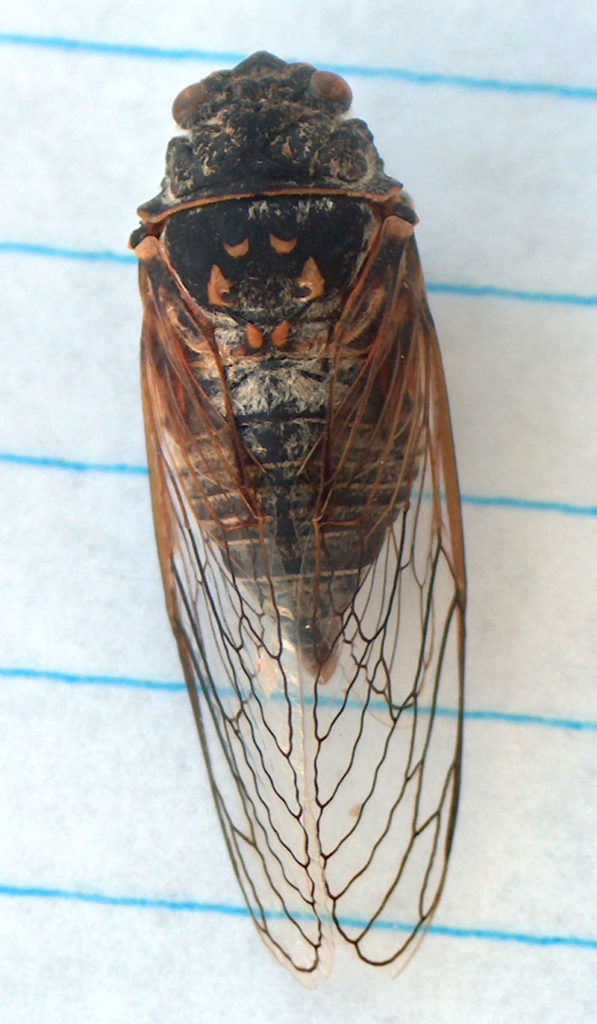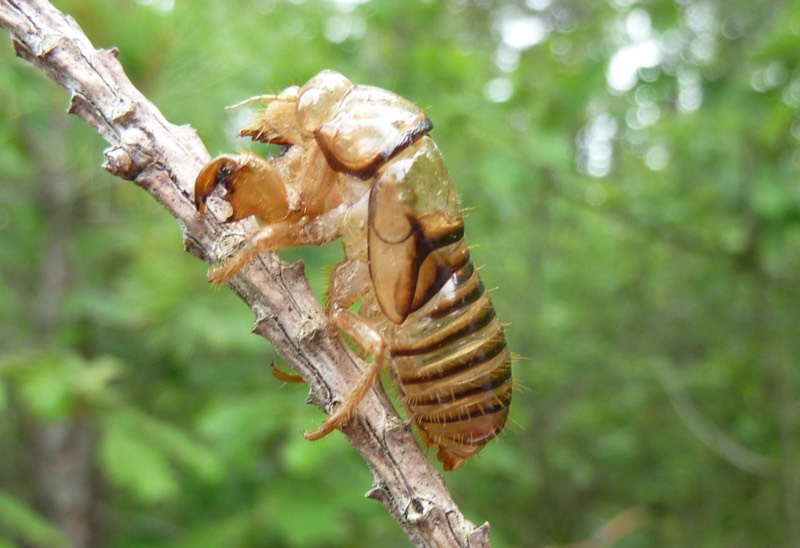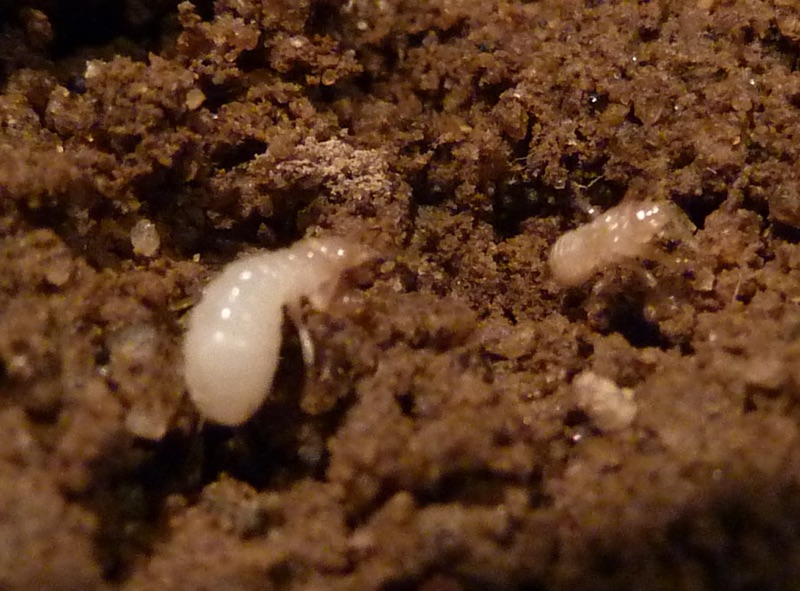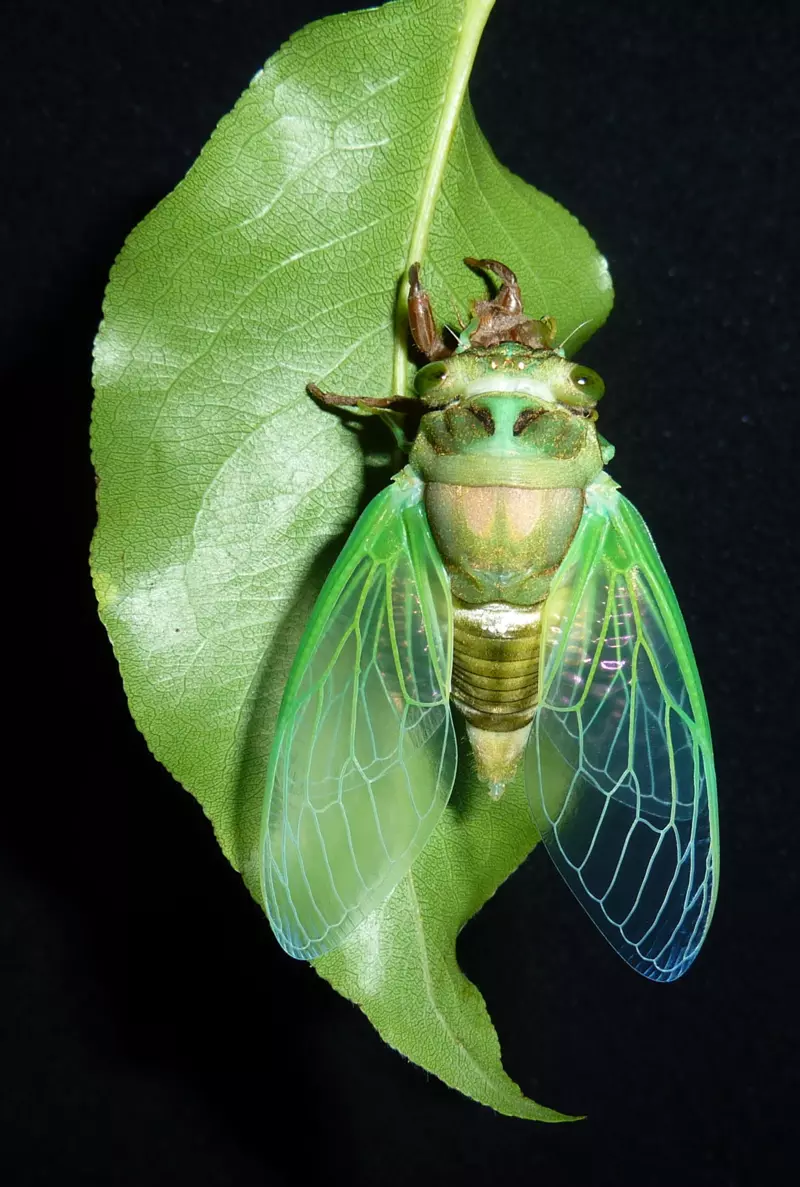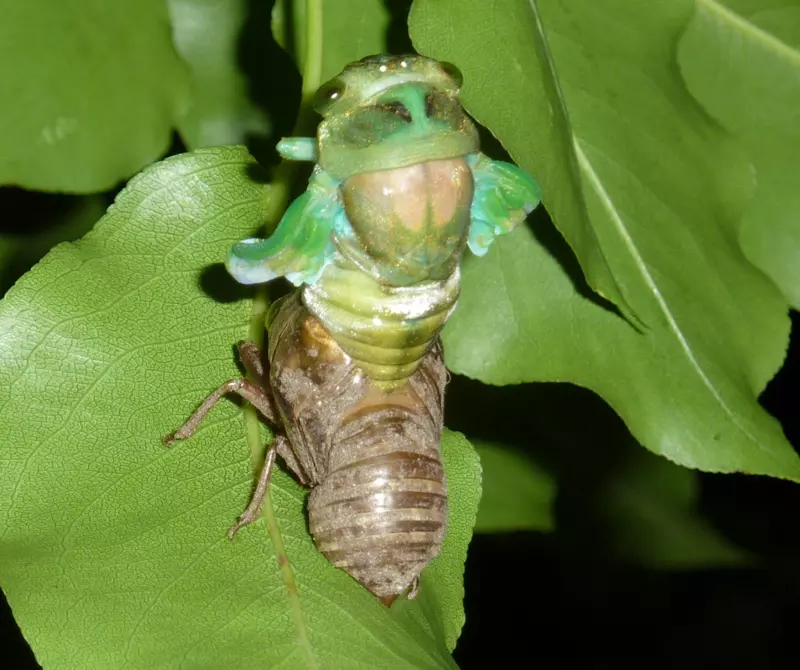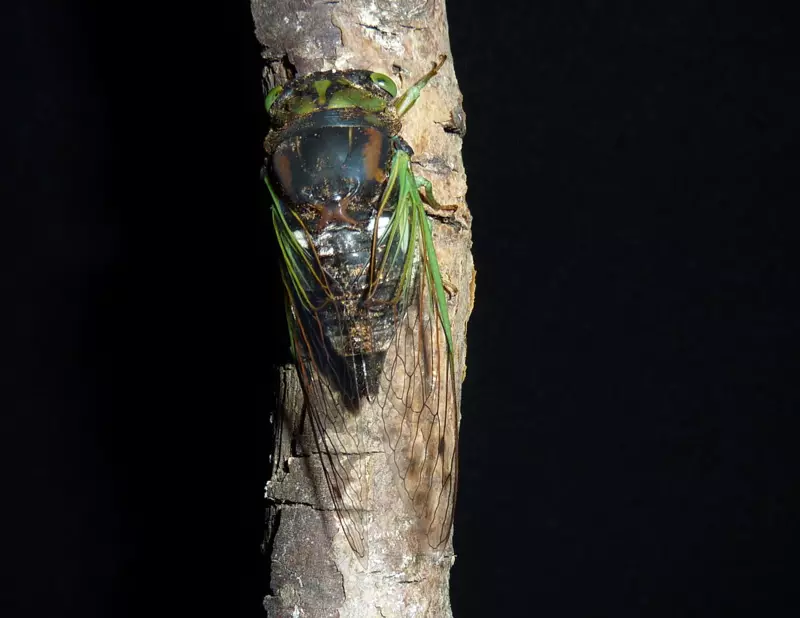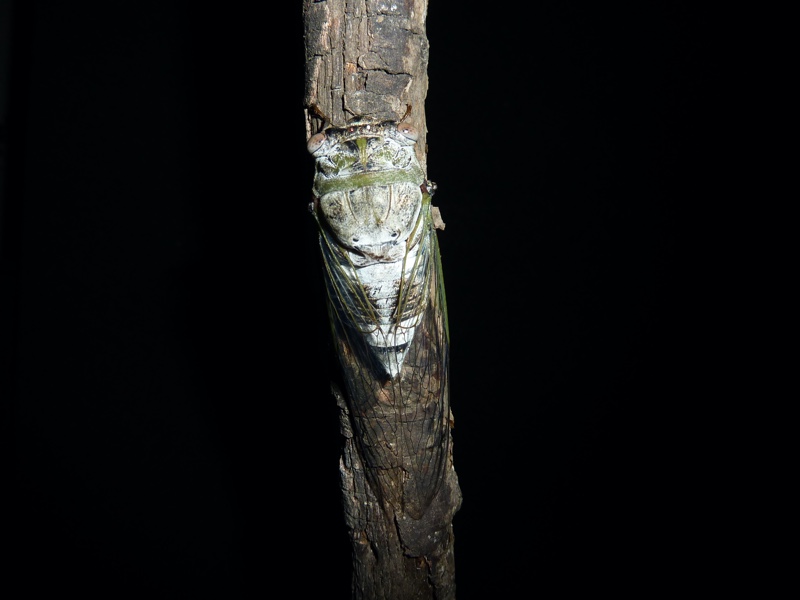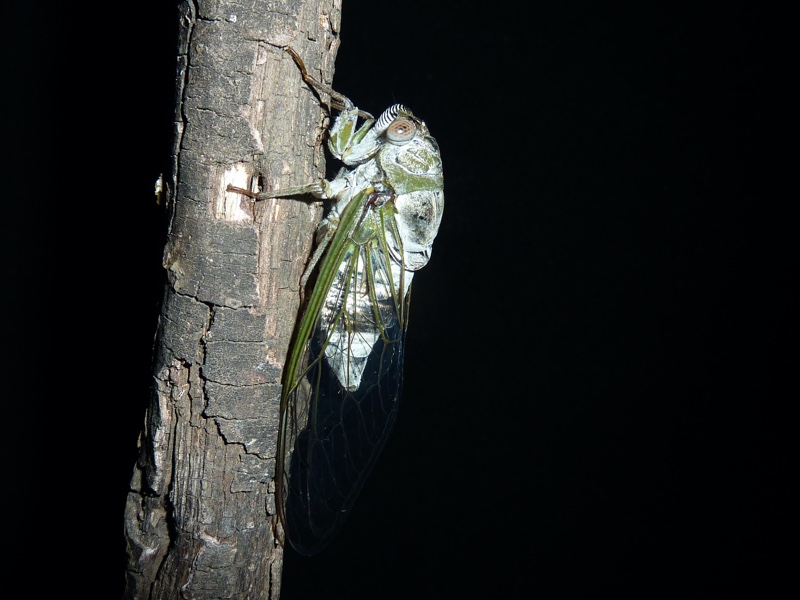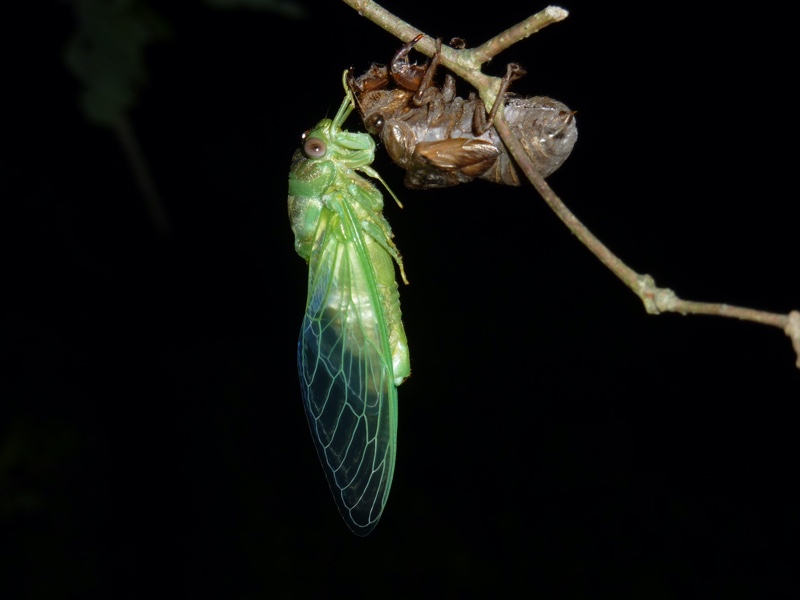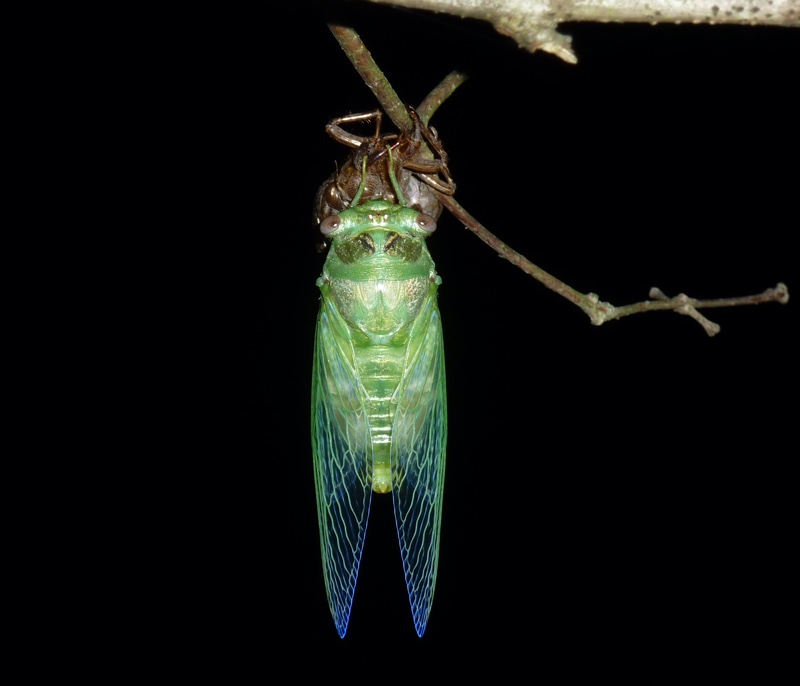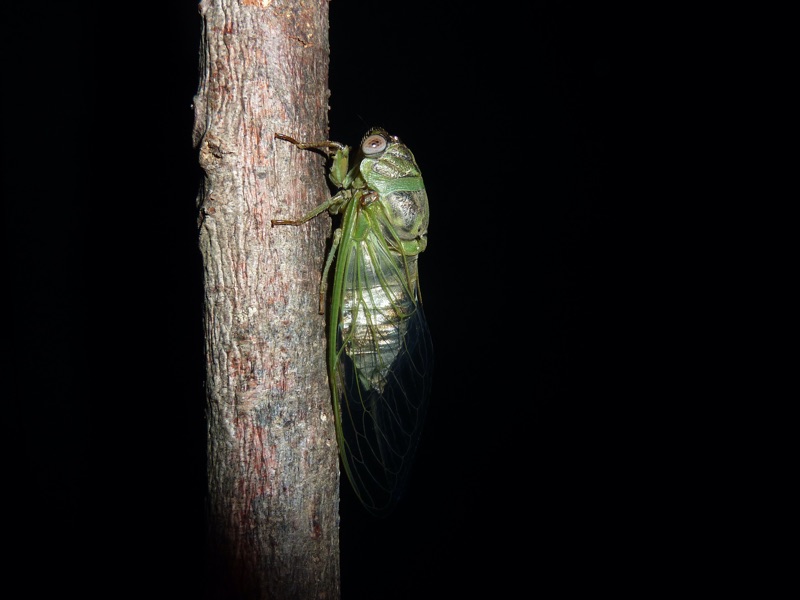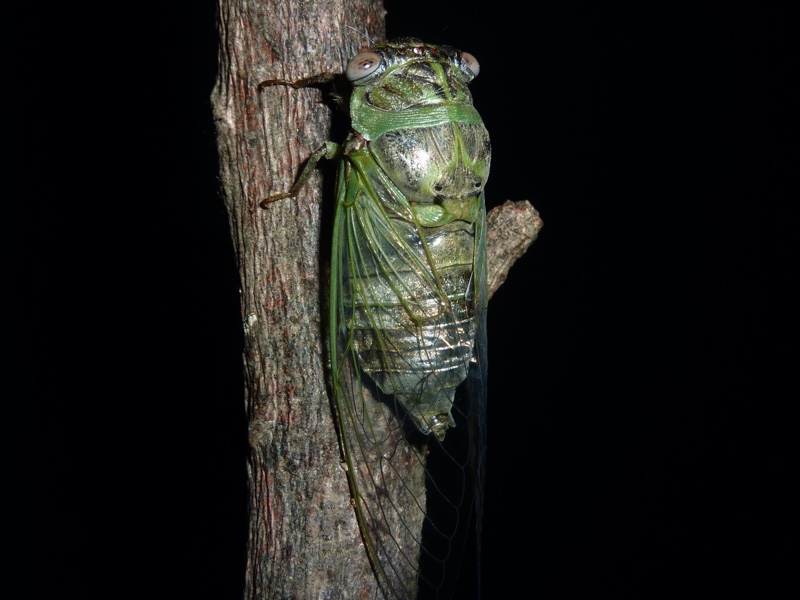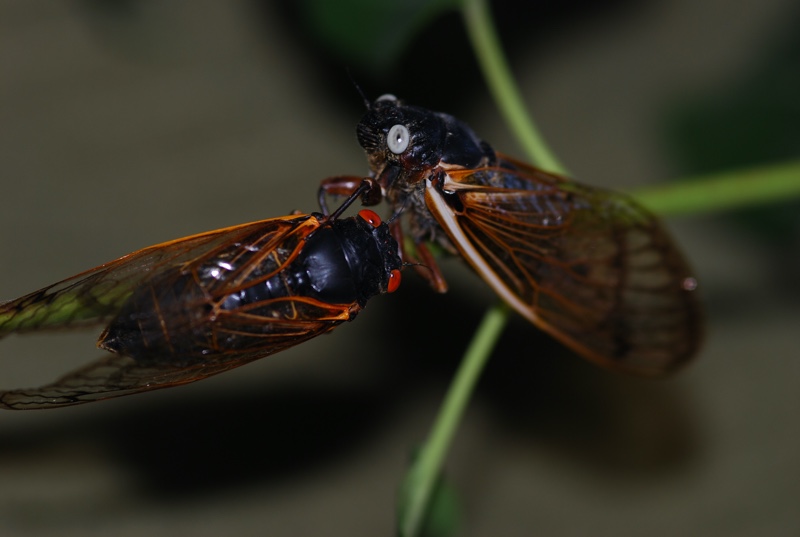Note: no major broods emerged in 2009.
Mary — those are Tibicen cicadas, and they’ll be around for the rest of the summer.
Comment by Dan — August 20, 2009 [AT] 9:00 pm
Yes. Buy The Songs of Insects by Lang Elliott and Wil Hershberger. It has many songs of North American cicadas.
Comment by Dan — August 20, 2009 [AT] 11:55 am
Hi,
does anyone know of commercially available cicada song/call recordings?
I live in Philly Pa. &
we have annual cicadas.
Don’t know the specie
but it produces a metallic/castenet type of sound.I think it’s really cool.
Comment by Bob — August 20, 2009 [AT] 11:42 am
I have seen these in Northern VA/DC area the last two weeks….primarily at my front and back door lights in the evenings. I can hear the trees full of them, which compeltely freaks me out now that I know what they look like.
How long can I expect them to be hanging around town?
Comment by Mary — August 18, 2009 [AT] 5:42 pm
Hello Chris. The Periodical cicadas have come and gone (a small emergence was noted in New Jersey). I live in New York and heard an annual cicada call 2 days ago. They usually take another week or two before they begin a noticeable chorus. Lets keep our fingers crossed and keep listening.
Comment by Elias — July 5, 2009 [AT] 5:32 am
i have a question for the experts im in nj and have not heard cicadas yet and its early july are they going to come in late or not come due to the cold spring?
Comment by chris egan — July 4, 2009 [AT] 11:11 pm
I have more than a dozen holes in my garden and have seen about eight left shells on the house, tree or swing. I have seen this Cicada (see website: http://agiesea.blogspot.com/2009/06/was-ist-das-fur-ein-insekt.html) about two weeks ago and now the neighbor hood is full of the singing. Not all time but loud. What brood is it and what type of Cicada is it. I come originally from Germany and never heard about Cicadas. My position is Virginia Beach, VA, USA
Comment by Drachenfanger — June 30, 2009 [AT] 5:51 pm
Magicicada (the red eyed periodical cicada) ususally are done by the beginning of July in most northern areas. The latest I caught one here was July 2nd in Brookhaven, Long Island. This was last year during the very end of Brood XIV.
Comment by Elias — June 30, 2009 [AT] 7:55 am
How long do they keep up their racket?
Comment by Pam — June 24, 2009 [AT] 12:21 am
Day 20 for my Magicicada and she is no more. Almost 3 weeks, the longest I ever kept one in captivity. Hopefully there are some stragglers still left out there although the cool and rainy weather is not helping at all!
Comment by Elias — June 20, 2009 [AT] 7:18 am
Day 16 for the female from Staten Island. She is still going strong. This is the longest I have ever kept a cicada alive in captivity. Has anyone else seen any Magicicada? May make a trip to Brookhaven soon to see if there was any activity from Brood XIV. Last trip to Fanwood and S.I. revealed no cicadas.
Comment by Elias — June 15, 2009 [AT] 7:20 pm
Day 14 for the Magicicada septendecim female that was captured in Staten Island. A few days ago she oviposited. Not clear if she was able to mate with one of the New Jersey males as she was fairly young while they were in their prime. She looks strong so far. Hopefully she will get the record for longevity!!
Comment by Elias — June 13, 2009 [AT] 6:00 pm
The search yesterday in Staten Island did not turn up any specimens. Saw many beautiful parks: Blue Heron Nature preserve, Clay Pits Pond Park, Wolfe’s Pond Park, and Conference House Park. Found a shell at Clay Pits Park and was told by a park ranger they came up about a week ago. No calling heard. Returned to Fanwood NJ too since I was by the Outerbridge Crossing. Saw lots of shells but they were probably left over from the previous 2 weeks. No calling and no specimens. Has anyone else seen any Magicicada? Seems like the accelerated emergence is all over.
Day 14 in the mini colony. The only one left alive from the original Fanwood Brood is the Massospora stricken cicada. Half the cicada’s body is gone yet she is still alive! This insect never ceases to amaze me!!
Comment by Elias — June 7, 2009 [AT] 6:09 am
Day 12 in the mini colony. Lost the first male yesterday. the second male appears to be tiring. did not hear him call this AM. 3 females still alive, one is the recent Staten Island specimen.
Staten Island news is picking up on the early cicadas and published an article here.http://www.silive.com/news/advance/index.ssf?/base/news/124411770745200.xml&coll=1
Will probably search again over the weekend.
Comment by Elias — June 5, 2009 [AT] 4:05 am
Day 9 in the captive colony. The two males are calling like crazy and the one infected with Massospora is still flicking her wings to keep them going. The female that mated last time has begun to lay eggs in the branches I have in there. I have seen all aspects of their life style. What a cool present nature gave me.
Hope some others are finding stragglers. There are a lot of people in Brood II and Brood XIV land!
Comment by Elias — June 2, 2009 [AT] 7:36 pm
Took a trip to Staten island today. Found 2 cicada burrows in Blue Heron Nature Preserve but no skins/adults. Then went to Wolfe’s Pond Park and found some cast off shells on Sycamore trees only. Then after a long day and a good stroke of luck, 1 nymph came up at 8:30PM on a sycamore tree. He is molting right now and so far the process is going well. Learned a technique from Gerry Bunker and that is to transport nymphs horizontally in a plastic container to prevent them from molting which leads to certain deformity. Day 7 for the rest of the colony. The two males are still calling and one pair mated already.
Comment by Elias — May 31, 2009 [AT] 8:55 pm
Update on my mini colony that is being kept alive in a Butterfly pavilion. One young male started to sing today. The amplitude is very low. Also a female in the cage responded with wing flick signalling. Brought home 8 from New jersey, 6 still alive. Today is Day #4. Next couple of days may need to look in Staten island or back to Fanwood. Anyone have any other reports? I know the weather is terrible. We need some sunshine!!
Comment by Elias — May 28, 2009 [AT] 8:17 pm
Thanks to Charlene’s post I went to Fanwood. found 7 tenerals and captured one nymph which will eclose here in the comfort of my home. Heard some light M. septendecim choruses. did not see any M. cassini or M. septendecula. Some trees where covered with at least 100 exuvia. Some had none. The question is have we seen the maximum yet or is it just starting? Please keep an eye out for further emergence sites here in the North East.
Comment by Elias — May 25, 2009 [AT] 1:10 pm
Can anyone tell me places where cicadas are being seen in New jersey or New York. I will travel to document this interesting accelerated emergence. Parks where they have been observed or street intersections would be of greatest value. Thank you!
Comment by Elias — May 24, 2009 [AT] 7:51 am
Charlene, yes, they’re stragglers even though there are so many. They’re stragglers by virtue of the fact that they’re arriving 4 years early.
Comment by Dan — May 22, 2009 [AT] 7:02 pm
Our NJ town (30 miles west of Manhattan) is covered in Magicicadas. Can they be straggers when the entire town is covered in them? Here are some photos I took today:
http://charlenemc.smugmug.com/gallery/8295055_PTPhV#543177018_samDe
Comment by Charlene — May 22, 2009 [AT] 6:49 pm
Saw a whole lot of cicadas around Cedar Ridge Drive, in (Spotsylvania County) Fredericksburg, VA 22407
Comment by Selena Barefoot — May 18, 2009 [AT] 5:38 pm
We had one of these at our back porch light last night in Carroll County, Virginia. I thought it was some sort of very large bee (looked to be about the size of a humming bird!) but decided to do some research today after work and there it is! I see there have been a number of other sightings in Virginia recently.
Comment by Lori — May 18, 2009 [AT] 3:09 pm
